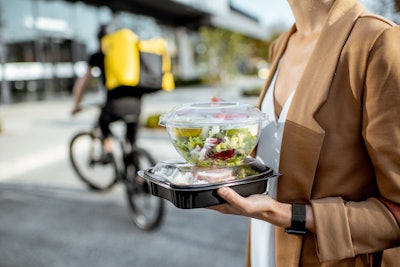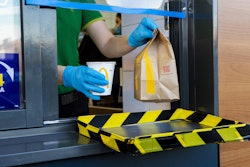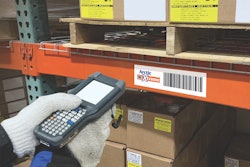
The Coronavirus disease (COVID-19) pandemic’s impact on the restaurant industry is unmistakable. The general strategy in how foodservice and the restaurant industry operates vastly changed once the virus became a global emergency. And once venues started opening up again, many of the trends that came about due to social distancing and shut down requirements remained because they were convenient for both customers and foodservice employees.
QR codes imprinted at tables for consumers to quickly get access to menus on their mobile devices instead of having to handle bulky printed menus that many others have touched are likely to stay long after the pandemic subsides. More restaurants flocked to digital platforms to manage reservations at locations that previously did not accept reservations and continue to accept them once restrictions were lifted. But one of the most prevalent themes in the industry during the pandemic is the increase of takeout.
When strict shutdowns plagued indoor dining, many restaurants whose original strategies did not include takeout had to pivot. Numerous locations beefed up their takeout offerings, expanding to online ordering, delivery and robust digital platforms to easily communicate with customers. Many flocked to third-party delivery services as well.
The increase in takeout greatly influenced foodservice packaging. Currently, the industry sees numerous major trends including ecofriendly containers, tamper-proof, heightened food safety and greater quality/durability.
Ecofriendly
Sustainability is an important part of the foodservice takeout industry since single-use plastics are one of the top contributors to waste. So many municipalities require a reduction or ban on single-use plastics in restaurants and foodservice locations, pushing these facilities to take on compostable, biodegradable and new material-based disposables.
“Across the globe, we are seeing a growing trend towards sustainable packaging,” says Tom Lunn, group general manager of innovation and sustainability at Detpak. “Businesses are looking for foodservice packaging that is responsible by design, right through from the product inputs, designing out plastic and excess materials, to ensuring the best end of life solutions for disposal.”
Paper is a common substitute for plastic in packaging right now, while some providers experiment with new materials that can biodegrade the same as paper but provide longer durability, for instance, straws made from discarded avocado pits.
Some foodservice locations provide reusable forms of packaging for frequent customers, like fast food chains using reusable tumblers and coffee mugs for beverages.
Tamper-proof
A recent report from Future Market Insights forecasts that the tamper-proof packaging market will grow at a CAGR of 7% to 8% by the year 2031.
Pre-pandemic, consumers expected their food to not be tampered with and trusted their foodservice provider to do handle their products in a professional manner. But mid-pandemic, the stakes are much higher. Restaurants wanted to make sure customers were able to visibly their food was safe to consume without the fear of contracting COVID-19, especially with the increase of third-party delivery drivers. This will likely continue to be a requirement for third-party delivery apps, but consumers might be less demanding of tamper-proof properties post-pandemic.
A survey from the Foodservice Packaging Institute protective/tamper-proof properties were the second most important factor in packaging, following the interest in clean and sanitary measures. However, less than 40% of those interested in tamper-proof expect to feel the same following the end of the pandemic.
Food safety
Numerous studies now show that the COVID-19 virus is very unlikely to be spread through food packaging, like one conducted by the American Frozen Food Institute (AFFI), in partnership with North Carolina State University researchers, which confirmed that there is no evidence for the spread of SARS-CoV-2 through consumption of food or in association with food packaging. However, interest in food safety is still important
Antimicrobial properties are an important part in the food industry and developers continually release new innovations in this department. Just this month, a new biodegradable material was developed by scientists from Harvard T.H. Chan School of Public Health and Nanyang Technological University Singapore that is said to kill harmful microbes and can extend fresh produce shelf life for up to three days. This will likely become more popular in foodservice packaging, especially as COVID-19 cases spike, increasing the interest in safety and hygiene again for the time being.
“COVID-19 has brought with it an increased focus on food safety and hygiene, a trend which continues today,” says Lunn. “This is very important to the brands we work with, as they want their customers to feel safe in their experience with their product.
“The pandemic has also driven substantial growth in the food delivery market, as customers spend more time at home and businesses tackle closures and restrictions. Many businesses have pivoted to a delivery model to meet this demand and with it, have switched to our range of foodservice packaging that best supports home delivery.”
Durability
While the foodservice industry looks for packaging that hits all these themes, the most important remains durability, pandemic or no pandemic. Consumers and foodservice operators both want the trust of using a packaging product that will hold up and prevent messes.
During the strictest of shutdowns when foodservice outlets pivoted to delivery and takeout, items that were not traditionally popular or even offered for take away such as soups and dishes that can easily spill became available since it was the only option. This increased the need for and capability of durability in packaging products.
Restaurants continue to look for high performance in packaging that fit the need of customers.
“Food safety and sanitation has always been the cornerstone of foodservice packaging,” says Ashley Elzinga, director of sustainability & outreach at Foodservice Packaging Institute. “We have seen a lot of innovation with tamper-evident/tamper-resistant components to protect not only the consumer, but employees as well. Performance is also a big factor to keep hot foods hot, cold foods cold, spill and leak proof, etc. We have seen an expansion of offerings focused around those attributes.”
All these trends are likely to continue considering the pandemic continues and even sees a surge of new cases from the new Omicron variant. Following the pandemic, foodservice outlets are likely to invest further into sustainable packaging but will not sacrifice durability and hygiene. Packaging providers will continue to innovate, research and invent new ways to accomplish all of these important characteristics.
“Food safety is fundamental to the very nature of foodservice packaging,” adds Elzinga. “The parameters around food safety are very rigid while sustainability has more variability. The definition of what is sustainable means different things to different companies and our industry has solutions to support its customers. The foodservice packaging industry, through FPI, has been working on the recovery of foodservice packaging for over a decade. Visit www.recyclefsp.org for more information on this work.”
The future of packaging will be greatly shaped by this pandemic, but it will lead to innovating and interesting methods in foodservice.




















